An Equestrian’s Anjou
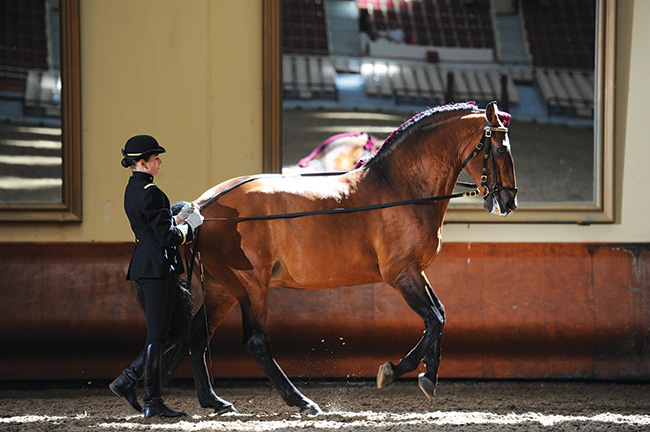
The historic province of Anjou has a long and illustrious equestrian tradition. Gillian Thornton visits Saumur, home to the French Horse and Riding Institute and the elite Cadre Noir.
As the lights dim and music heralds the start of the morning’s performance, there’s a palpable air of anticipation around the indoor arena. We all know we are in for a treat, a spellbinding display from pairs of supreme athletes, one with four legs, the other just two. I’m poised in a front-row seat for Les Matinales, an hour-long demonstration of classical horsemanship by members of the Cadre Noir, an elite squad of highly qualified riding masters, or écuyers, based in Saumur in the Loire Valley. Inscribed on UNESCO’s Intangible Cultural Heritage list in 2011, the French style of classical riding is steeped in tradition, enabling the horse to achieve the same grace and movements under saddle as it would when moving freely.
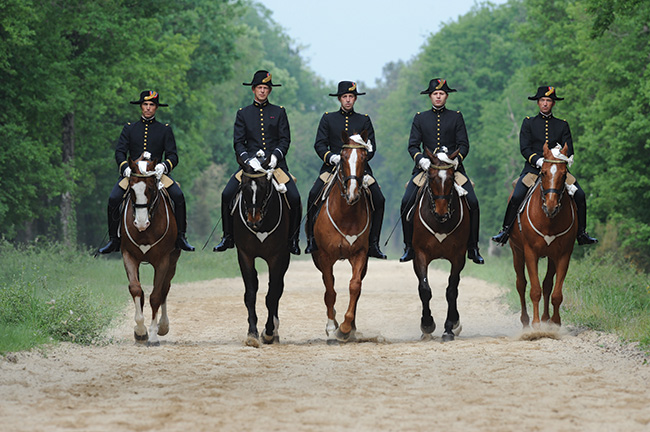
The écuyers in their iconic uniform © Alain Laurioux – Cadre Noir IFCE
Every member of the Cadre Noir is an expert in at least one of the Olympic equestrian disciplines – dressage, showjumping and eventing – and they all have a triple mission: to develop horse training, to teach riding for sport, and to teach the equestrian professions. But you don’t need to have any great knowledge yourself to enjoy a visit to their home at the French Horse and Riding Institute or IFCE (Institut Français du Cheval et de l’Équitation). The French Horse and Riding Institute has become a visitor attraction in its own right with broad appeal to anyone who loves horses, top quality sport, or just a good day out. And there is more than one way for visitors to enjoy it, too.
The IFCE resulted from a merger between France’s national stud farms – the Haras Nationaux – and the French Horse and Riding Institute, and today is run jointly by the Ministry of Sport and the Ministry of Agriculture. As well as the education of students, the Saumur complex hosts competitions and shows, and carries out research into horse welfare, veterinary matters and the technical performance of both horses and riders. And they love nothing more than to show the general public what they do.
Les Matinales takes place two or three mornings each month, depending on the season, and is designed to accustom young horses to the lights, commentary and spectators of an arena. Time your visit right and you might catch one of the four annual Gala weekends when the Cadre Noir performs a themed show in full ceremonial costume, a performance that also goes on the road each year to one French city and one overseas.
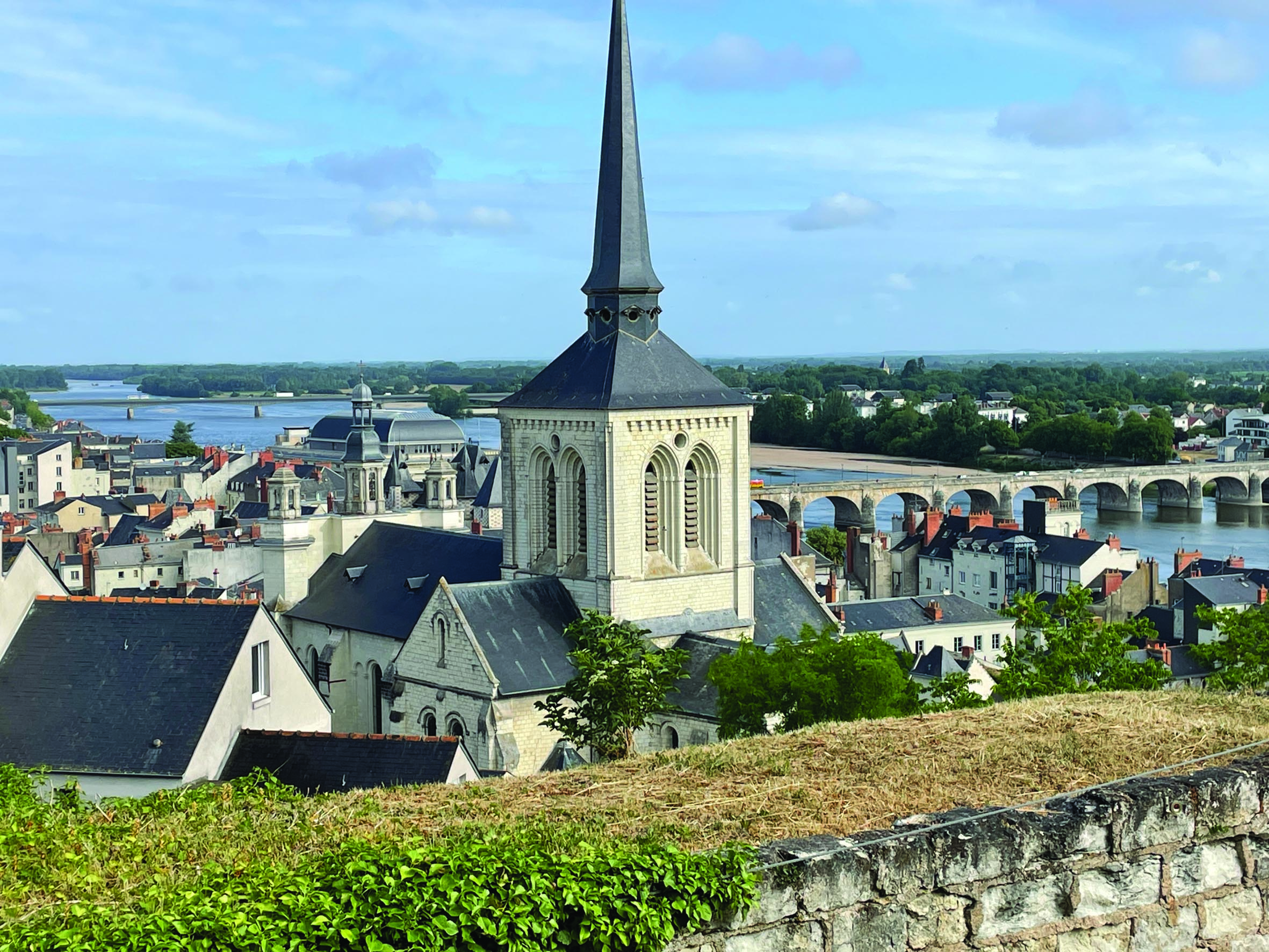
A view over Saumur and the Loire © Gillian Thornton
Equestrian Heart
The historic province of Anjou has long been associated with horses and today includes a number of stud farms such as the high-profile Lion-d’Angers, which hosts regular international competitions. The lush Anjou countryside is also an idyllic place for a holiday hack for visitors in search of the ultimate in slow tourism – ask at local tourist offices about riding stables in their area.
But the beating heart of equestrian Anjou is here at Saumur, the town’s horse-related history going back to the 16th century when Henri IV founded a Protestant University that included an equestrian academy. Horse breeding and equitation skills stepped up a gear in the early 19th century after the decimation of Napoleon’s cavalry. Civilian riding masters were brought here from Versailles, the Tuileries and Saint-Germain to a new cavalry school, and in 1825, the Cadre Noir was born. Civilian instructors were gradually replaced by their pupils – the écuyers, with their distinctive black and gold jackets – until eventually the Cadre Noir became an entirely military organisation.
But as horses became redundant on the battlefields of the 20th century, so the future of the Cadre Noir came into question – until the rise in riding for pleasure saw a new purpose for this highly-skilled team. In 1972, the National Riding School was created to prepare horse riders for high-level teaching diplomas and top-level competition.
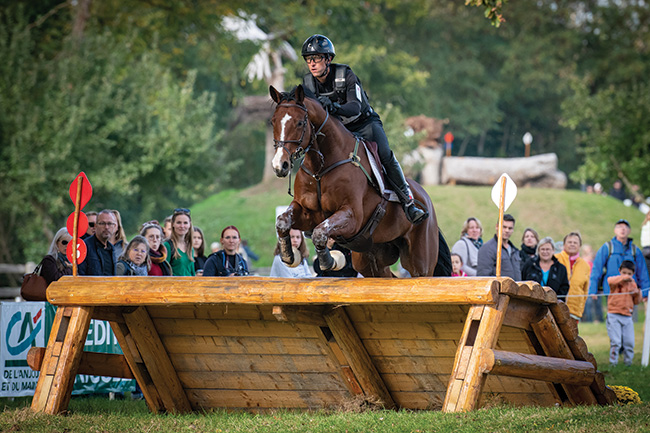
Olympic champion Arnaud Boiteau © Benoit Lemaire – Cadre Noir IFCE
The Highest Standards
Today the Cadre Noir draws candidates from both civilian and military backgrounds, numbering between 30 and 40 écuyers at any one time. Recruitment is highly selective and all successful candidates must be riding instructors already, as well as successful international competitors in one of the three Olympic disciplines. Once accepted, they will pass on their knowledge to the 1,500 French and foreign students who come here every year to train.
Watch a show in the arena here and you’ll see dressage movements familiar from TV coverage of Olympic competitions, with the added excitement of the famed ‘airs above the ground’. With their roots on the battlefield, these three demanding movements are a highlight for any spectator, not to mention the écuyer in the saddle or standing alongside. The horse stands on its hind legs for the courbette; kicks strongly backwards and upwards for the croupade; and combines both movements in one breath-taking leap for the capriole, the name recalling a ‘young goat’.
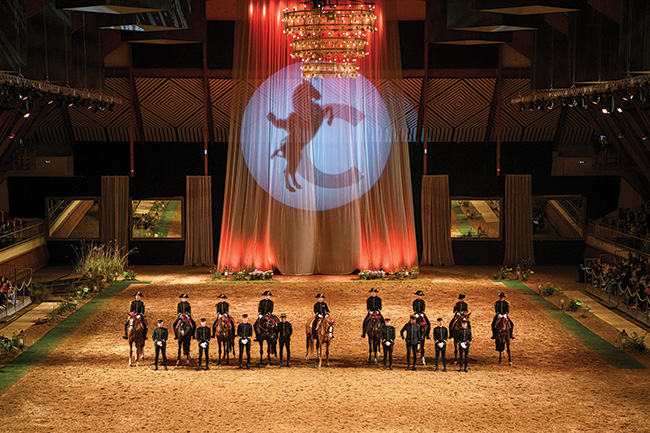
Be sure to book tickets for one of the super shows © Benoit Lemaire – Cadre Noir IFCE
But if you can’t manage to visit the IFCE during a Cadre Noir performance, you can still enjoy an insight into this unique institution on one of the Classic Tours which take place most days throughout the year. I take an afternoon tour with Léa, who fills me in on a few statistics as we walk into one of the many stable yards which accommodate up to 400 horses at any one time. Around 300 equine athletes belong to the school, the others owned by trainees who can spend up to four years studying here. Each student will work three or four horses a day, an écuyer as many as eight. Meanwhile, some 50 grooms ensure the equine residents enjoy every creature comfort, aided by fully-automated systems that distribute food and water, and even dispose of soiled bedding, some 6,000 tonnes a year being given free to local mushroom farmers.
We stop to watch a rider schooling in an outdoor manège before heading down a line of immaculate boxes. It’s not every day I meet an Olympic champion, so I’m thrilled to find Qing du Briot with his head over the stable door. A member of the 2016 French Eventing team, this veteran competitor was ridden into Gold Medal possession in Rio de Janeiro by Lt Col Thibaut Vallette, Écuyer en Chef at Saumur since 2021.

The spectacle put on for the public @ Alain Laurioux – Cadre noir IFCE
Léa shows me the luxury horse shower and solarium where these elite equine athletes relax. And I meet some of her favourite residents, including Tempo, a 4-star dressage champion who clocks in as the Institute’s tallest member. At over 18 hands high, Tempo enjoys the added luxury of a double-sized stable for maximum comfort.
Tour over, I head back to my overnight base in Saumur at the stylish Hôtel Anne d’Anjou, stopping off to visit the Saumur Carriage Collection, a permanent collection of more than 20 horse-drawn carriages that shows the evolution of the vehicles. Free to visit, the display is hosted by Bouvet Ladubay wine producers in collaboration with the IFCE and local carriage-driving association Saumur Attelage, so I slip in a tasting at their on-site shop too and come away with some liquid souvenirs. Next morning, I’m one of the first in my seat for Les Matinales. However good your everyday French, I’d recommend taking advantage of the free headsets unless your equestrian vocabulary is tip-top. The show starts with two young horses demonstrating basic dressage movements, though there is nothing basic about the way they float over the arena and seamlessly change gait and direction without visible signals from their riders.
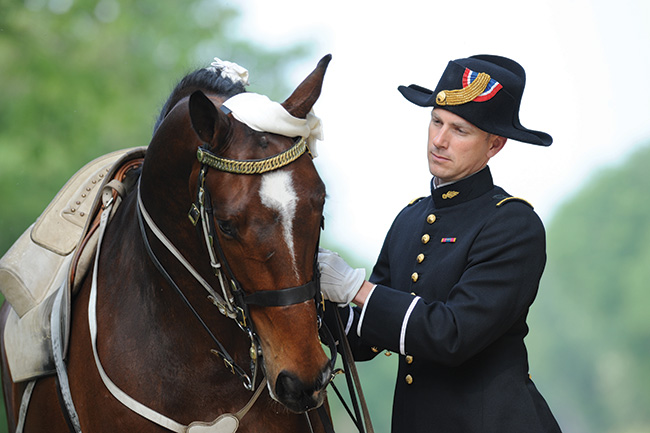
Écuyers train with as many as eight horses a day © Alain Laurioux – Cadre Noir IFCE
The show is split into eight themed sections, each one showcasing different skills such as long reining and, of course, those thrilling airs above the ground. It’s far more diverse than I expected. The French national vaulting team are based here too and I sit spellbound as 2018 World Champion Lambert Leclezio performs a combination of ballet and athletics on the back of a cantering horse.
Best in Show
There’s an element of fun too as one écuyer demonstrates precision jumping over a drinks trolley, then a difficult upright post, and finally a picnic table surrounded by colleagues sipping sparkling Saumur! And I’m thrilled when he rides his chestnut gelding right up to the railing and encourages Chardonnay to stretch his head into our laps for a fleeting touch of that velvet muzzle.

The feats horses and riders perform are astonishing © Benoit Lemaire – Cadre Noir IFCE
But the highlight is still to come, a grand finale in which Thibaut Vallette leads six prestige pairs into the arena for a musical ride, horses and riders working together in perfect harmony, just as they have done here in Saumur for centuries. Exquisite, from every seat in the house.
The IFCE is open to the public from early February to early November. Classic Tours are €8 for adults, €6 for under-16s. Tickets for Les Matinales are €19 and €13. Tickets for Gala Shows are adults €35-€70, under-16s €15-€40.
For dates, tickets and general visitor information, visit www.ifce.fr/en/cadre-noir

Fairy-tale Saumur Castle as seen from a room at the Hôtel Anne d’Anjou © Gillian Thornton
Sauntering Round Saumur
Saumur is a town that has always enjoyed the good life. Home to the Dukes of Anjou. European capital of Protestantism. Heart of French military horsemanship. And an innovative centre of wine-making. Small wonder that this pretty riverside town is part of the national network of Villes et Pays d’Art et d’Histoire – Towns and Areas of Art and History.
Drop in to the Tourist Office overlooking the river to pick up the free historical walks leaflet with its three colour-coded routes past the town’s most significant buildings, all dominated by the 14th-century château. The old keep and royal fortress became the luxurious residence of the Dukes of Anjou in the 14th century but is now a museum of decorative arts.
Grand public buildings and private mansions come thick and fast, a tower here, a turret there, all in pretty white tufa stone. For an atmospheric refreshment stop, try Place Saint-Pierre in the heart of the medieval city, overlooked by half-timbered houses and the towering façade of St Peter’s Church.
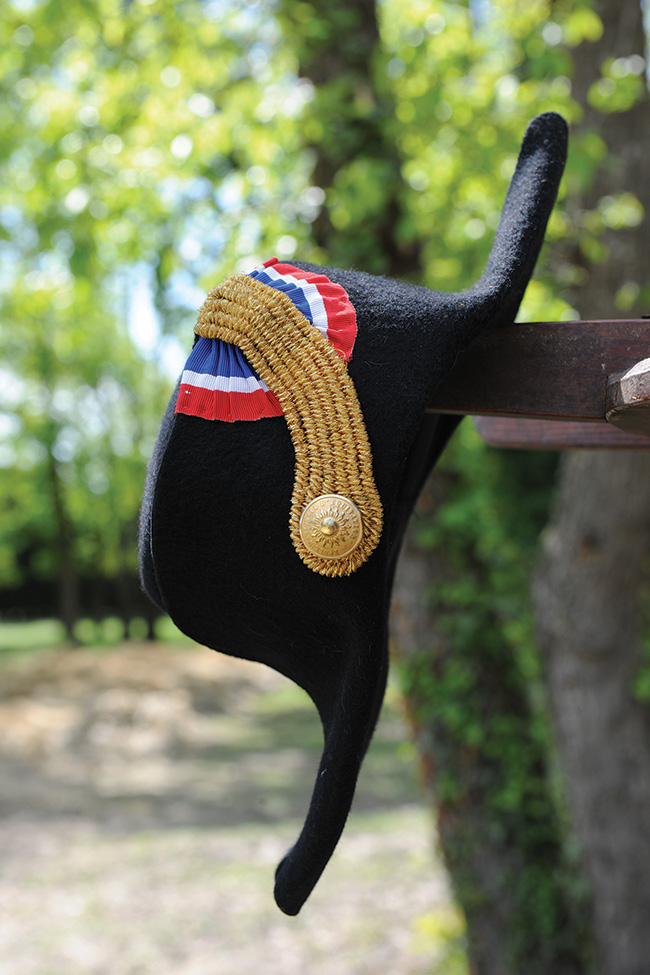
The hat forms part of the Cadre Noir’s famous uniform © Alain Laurioux – Cadre Noir IFCE
Travel Essentials
Gillian travelled with Brittany Ferries from Portsmouth to Saint-Malo, a three-hour drive from Saumur (www.brittanyferries.com), and stayed at the Hôtel & Spa Anne d’Anjou, an 18th-century riverside mansion that offers unique views from the garden, pool and rear windows to the hilltop château.
www.hotel-anneanjou.com
The Anne d’Anjou is a short walk from Place Saint-Pierre where the summer menu at Bistrot de la Place includes a sublime cold soup of strawberries and tomatoes, and an apricot sablé dessert of which dreams are made. www.bistrotdelaplace-saumur.com
From France Today magazine
Lead photo credit : The Cadre Noir showcases the skills of horsemanship at their very highest © Alain Laurioux - Cadre Noir IFCE
Share to: Facebook Twitter LinkedIn Email
More in Cadre Noir, French Horse and Riding Institute, Saumur
Leave a reply
Your email address will not be published. Required fields are marked *



